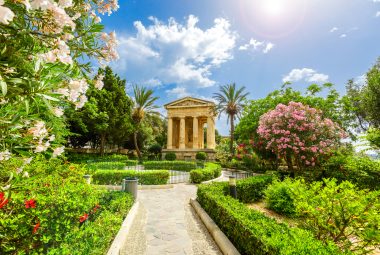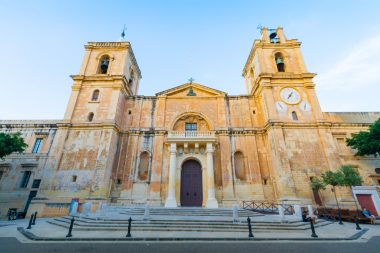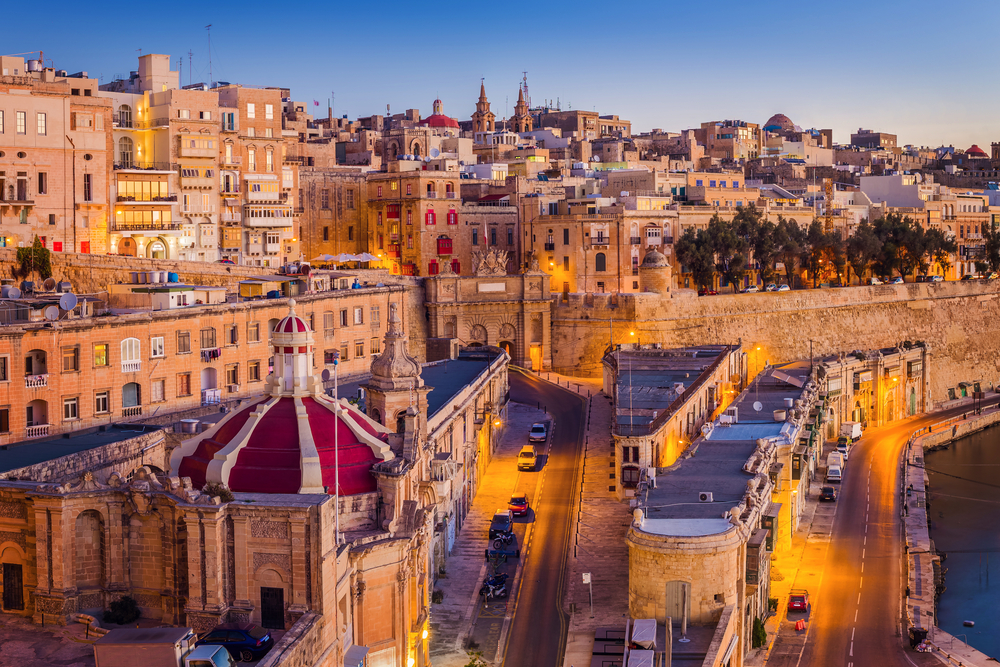The city of Valletta in Malta was founded in 1566 as a refuge for the wounded during the Crusades of the 16th century. It is located on the northeast coast of the main island between Grand Harbour and Masamxett Harbour, the two largest natural harbours in the Mediterranean. Valletta is the smallest capital of all EU countries, both in terms of area and population. Due to the buildings that can be found everywhere in the city, which are architecturally at home in the Baroque period, Valletta exudes the unique charm of a huge open-air museum.
The streets were laid out as wide and grid-like as possible in order to have a little cooling during the warm summers due to the sea wind. Despite its small size, Valletta boasts many historical sites that date back to the 16th century and are the reason why the whole city was classified as a World Heritage Site by UNESCO in 1980.
Facts about Valletta
- Compact size: Valletta is known for being one of the smallest capitals in Europe. The city covers an area of only about 0.8 square kilometers. Despite its small size, the city is densely built up and rich in historical sights.
- Population: The population of Valletta is relatively small for a capital city; it has about 5,600 inhabitants. This gives the city an almost village-like feel, especially in the less touristy areas.
- Official languages: Two official languages are spoken in Valletta: Maltese and English. Maltese is a unique language that has Semitic roots and is heavily influenced by the Italian language, especially Sicilian and Italian. English is also widely spoken, which makes communication easier for international visitors.
- UNESCO World Heritage Site: Valletta is a UNESCO World Heritage Site, a recognition it received in 1980. The city was founded in the 16th century by the Knights of the Order of St. John and is known for its well-preserved architecture from the Renaissance and Baroque periods.
- Rich history: Founded in 1566 after the Great Siege of Malta, Valletta was named after Jean Parisot de la Valette, the Grand Master of the Order of Malta, who led the defence against the Ottomans. The city was designed as a fortified refuge and has witnessed many historical events.
- Cultural centre: Valletta was the European Capital of Culture in 2018. The city offers a lively cultural scene with numerous museums, theaters and art galleries. The Manoel Theatre is one of the oldest theatres in Europe that is still in operation.
- Architectural heritage: The architecture of Valletta is a mix of medieval, baroque and modern architecture. Striking buildings such as the Grand Master’s Palace and St. John’s Co-Cathedral, known for its magnificent interiors and ornate marble floor slabs, are highlights for visitors.
History

After the Knights of the Order of Malta had successfully ended the siege by the Ottomans, they began to build a fortified city on the headland of Monte Sciberra. Their elevated position between the Grand Harbour and Masamxett Harbour ensured the possibility of control over the two harbours. On the
On 28 March 1566, the Grand Master of the Order of Malta, Jean de la Valette, laid the foundation stone.
The Italian architect and builder Francesco Laparelli was hired to design the defensive walls and the roads, assisted by his Maltese assistant Gerolamo Cassar. On 18 March 1571, Valletta became the headquarters of the Order of Malta and was named after Jean de la Valette, who died before its completion. The further expansion of the city was led by his successor Pierre de Monte. The construction projects were made possible mainly by the financial support of Pope Pius V and King Philip II of Spain. It took another 20 years until Valletta was completed.
In the case of urban development, the 17. and 18th century, as military concerns were no longer in the foreground and more and more buildings were built for administration, trade or commerce. As a result, Valletta experienced a heyday and became a magnificent baroque city comparable to Prague or Vienna.
With the opening of the Suez Canal in 1869, Valletta gained additional importance as a port city. In both world wars, warships also anchored off Valletta. It was partially devastated by air raids by Germans and Italians and only the defensive walls withstood the hail of bombs.
Attractions in Valletta
Valletta is now one of the main attractions for tourists in Malta. There are countless cafés and wine cellars throughout the city that invite you to stop for a bite to eat. Those interested in culture can enjoy a wide range of events, such as theatre and concerts by leading opera stars. The sometimes hectic
The hustle and bustle of the day slows down in the evening and allows you to take a relaxing walk through the streets of the capital, illuminated with soft light, to enjoy the magical atmosphere of the historic buildings in peace.

St. John’s Co-Cathedral in Valletta is the most magnificent church in Malta and was built between 1573 and 1578. However, the interior design took another hundred years to complete. It served as the headquarters of the Archbishop of Malta, along with the Rotunda in Mosta, which earned it the name Co-Cathedral. Attached to St. John’s Co-Cathedral is a museum where many works of art are available to those interested.
tourists.
The Grand Master’s Palace, also built in the 16th century, does not have to hide behind St. John’s Co-Cathedral in terms of splendour. The palace used to be the residence of the Grand Master of the Order of Malta and is currently the seat of the President of Malta. The interiors of the building are decorated with numerous paintings and
decorated with portraits that commemorate the different inhabitants of the palace. In the armoury there are over 5700 weapon parts on display, which date back to the age of knights.
The National Archaeological Museum is located in a former quarter of the Order of St. John, the Auberge de Provence. Not only is the building itself a sight to see, but it also has many interesting exhibits inside. Among them are the 4000-year-old Magna Mater figures “the Sleeping One” and “the Venus of Malta”. The museum also provides information about the construction of the temples in Malta, which are up to 5000 years old, and is the ideal place to learn more about the archaeological sights of the Republic of Malta .


